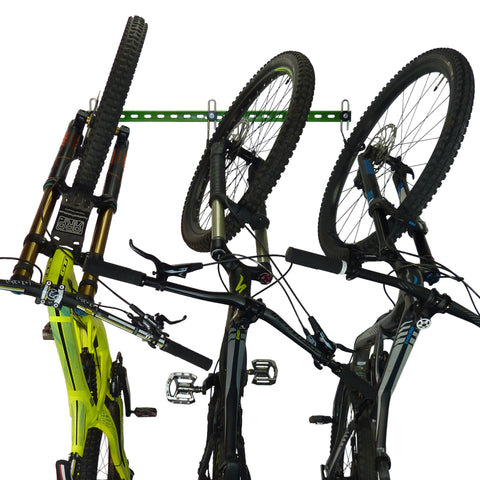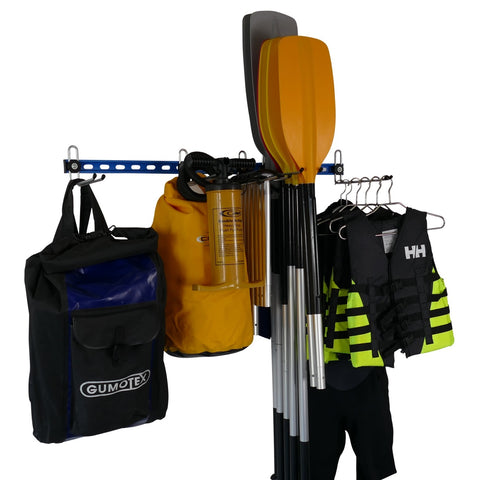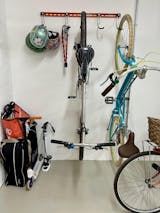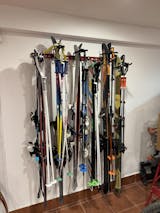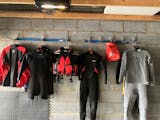
What can you store in a garden shed in the UK?
Share
-
Can you use a shed for storage?
-
How do you store things in an outdoor shed?
-
What to put inside a shed?
-
What should not be stored in a shed?
But lets start with the big question;
What can you store in a garden shed in the UK?
It is generally okay to store things in a shed in the UK over winter. However, because a shed isn’t heated and the UK climate is damp, it’s best not to store things in there that might absorb moisture like fabric, cushions, clothing, cardboard boxes, paper (including photographs), wooden furniture or delicate electronic equipment.
More on that later but, assuming you have fairly dry and well maintained shed, here are a few ways you can use GearHooks to make the most of the space in your shed:
Can I store Garden Tools in a shed?
Garden tools can be stored in a shed without any problems. In fact they are probably the most common things that are stored in a shed. There are many things you can buy to store tools from glorified bins to individual wall hooks. We think there are a few things to consider:
- don’t have all the tools leant up in a corner or mixed up together in a bin. They will get tangled and hard to get out when you need them.
- don’t use up all the precious wall space in your shed by hanging a spade here and shovel there. Before you know it the walls will be covered and you will have nowhere to put anything else.
We have designed the GearHooks Garden Tool Rack to take as many as 30 of any kind of tool (from garden forks to chainsaws) in just 1 metre of wall space.
The tools are stored one behind the other on 3 or 5 long hooks so the tools you use most often are at the front and the others are all easily accessible.
We have some other articles here that you might find useful too:
Can I store bikes in a shed?
Bikes can be stored in a shed, but sheds are small so you need to be clever with how you store them. Having them all leant up against the wall, and against each other, means they are likely to get scratched and Sod’s Law means that the one you want will always be at the back.
Hanging bikes on the wall is probably the easiest way to save space while making access to each bike simple. We design and manufacture single bike hooks that you can fit directly to the uprights in the shed by drilling just one hole.
We also make 1 metre wide bike racks that you can fit between battens to take from 3 to 5 bikes.
Can I store skis and snowboards in my shed?
Skis and snowboards can be stored in a shed (or garage) but they should be very dry when you put them away and we would advise protecting the steel edges by leaving ski wax on them or rubbing them with an old candle.
It is important that they are not left standing on their tails on the floor as any dampness with cause rust and may make the tails delaminate.
We manufacture wall mounted ski racks that take up to 12 pairs of skis or wall mounted racks for up to 6 snowboards in just 1 metre of wall space. Skis and boards can drip dry and will have plenty of space around them for air to circulate.
We have written some other articles about storing skis and snowboards that might be of interest:
Can I store golf bags in a shed?
As long as it is dry, golf bags, clubs and trolleys can all be stored in a shed. However, if you don’t want to find your golf bags gnawed by rodents, they should be empty of any food and hung up on the wall.
We manufacture a one metre long wall mounted golf rack that will take up to 5 bags or trolleys. This keeps them off the floor, out of the way and somewhere they can stay dry if it’s been a wet round. It’s far better than leaving them in the boot of the car or on the garage floor.
We have another article here with some more tips about how to store golf bags:
Can I store sports equipment in a shed?
You can store all sorts of sports gear like tennis rackets, hockey sticks and a mix of general sports gear in a shed. We wouldn’t advise keeping any clothing or bags in a shed in case they get damp and go mouldy.
As well as racks for a single type of sports equipment (like bikes or skis) we make an all-purpose Sports Equipment Rack that will take a mixture of sports equipment like bikes, golf bags, skis, skateboards, rackets and much more.
This will be a good solution if you play multiple sports and have just one or two bits of each type of gear.
We have an article about how to store sports equipment here:
Can I store climbing gear in a shed?
Climbing ropes, harnesses, helmets and all the fiddly little bits of climbing paraphernalia can be stored in a shed. Some people keep them in big sports bags or plastic boxes. However, if you want to keep them better organised, off the floor and make them more easily accessible, so you can choose the gear you need for each trip, a wall mounted rack might be better.
We make a wall mounted climbing rack, with 3 or 6 long double hooks, that will take everything from several ropes to dozens of carabiners and other gear.
Everything is in one place, easy to see, quick to get at and it looks pretty cool too.
Can I store watersports gear in a shed?
Wherever you store watersports gear it all needs to be VERY dry when you put it away. Things like wet suits, buoyancy aids and kit bags will all go mouldy in no time if they are wet. If you store gear in a shed it should be waterproof and have enough ventilation to allow air to circulate to keep things dry.
Storing gear in kit bags on the floor or in sealed plastic boxes will inevitably lead to damp building up and mildew forming. This can ruin watersports equipment.
Our Watersports Rack and Diving Gear Rack allows wet suits, buoyancy aids and jackets to be hung on hangers on the rack so air can circulate. Other hooks take everything else from inflatable paddleboards and paddles to stab jackets and regulators.
We have a useful article on how to store watersports gear here.
What are the top ten things people store in their sheds?
So, to summarise, here is a list of the most common things people keep in their sheds:
Garden Tools: Sheds are commonly used to store various garden tools such as shovels, rakes, hoes, lawn mowers, trimmers, and wheelbarrows.
Outdoor Equipment: Items like bicycles, sports equipment, camping gear, and outdoor furniture are often stored in sheds when not in use.
Seasonal Decorations: Sheds provide convenient storage space for seasonal decorations like Christmas lights, Halloween props, or other holiday ornaments.
DIY Tools: Many people keep a collection of DIY tools in their sheds, including screwdrivers, hammers, drills, saws, and other hand or power tools.
Lawn Care Supplies: Shed storage is ideal for lawn care supplies such as fertilizers, pesticides, watering cans, hoses, sprinklers, and gardening gloves.
Potting Supplies: Gardeners often store potting soil, plant pots, gardening gloves, trowels, and other supplies used for planting and potting in their sheds.
Outdoor Toys: Children's outdoor toys such as balls, bikes, scooters, and playsets are frequently stored in sheds to keep them organized and protected.
Paint and DIY Materials: Sheds can serve as storage for paint cans, brushes, rollers, and other DIY materials, keeping them separate from living areas.
Seasonal Tools: Some seasonal tools like snow shovels, snow blowers, and ice scrapers are stored in sheds to free up space in garages or homes.
Miscellaneous Items: Sheds often become a catch-all space for miscellaneous items like extra storage boxes, ladders, extension cords, cleaning supplies, or pet-related items.
What else do I need to think about if I’m storing things in the shed?
Whatever you store in your shed, there are a few factors to consider to ensure that your belongings remain in good condition:
Weatherproofing: Make sure your shed is weatherproofed to protect your items from moisture, rain, and snow. Check for any leaks or gaps in the shed's structure and consider using weather stripping or sealant to prevent water from seeping in.
Ventilation: Adequate ventilation is important to prevent the buildup of condensation, which can lead to dampness and damage to your stored items. Ensure that your shed has proper ventilation or consider adding vents if necessary.
Protection from pests: Take measures to protect your belongings from pests like rodents or insects. Seal any openings or cracks in the shed to prevent access, and consider using pest control methods such as traps or repellents if necessary.
Proper storage: Organize your items in a way that minimizes the risk of damage. Use sturdy shelves, storage containers or wall mounted storage racks to keep items off the ground and prevent them from getting damp. Consider covering sensitive or delicate items with plastic or cloth for added protection.
Security: Ensure that your shed is secure against theft. Use sturdy locks or security measures to prevent unauthorized access.
What should not be stored in a shed?
In a shed, various items can potentially get damp due to factors like humidity, condensation, or water leaks. Here are some examples of items that are more prone to dampness in a shed:
Cardboard Boxes: Cardboard is susceptible to moisture absorption, and if stored directly on the ground or in contact with damp surfaces, boxes can become damp and potentially damaged.
Fabrics and Clothing: Textiles, such as clothing, curtains, cushions, or fabric-based items, can absorb moisture from the air and develop a musty smell or even mold if stored in a damp shed.
Paper Documents: Paper is highly sensitive to moisture and can become wrinkled, warped, or discolored when exposed to damp conditions. Important documents or books should be stored in sealed containers or kept in a dry environment.
Wooden Furniture: Wood can absorb moisture and swell or warp when exposed to dampness. Wooden furniture pieces stored in a shed should be protected with a moisture barrier, such as a tarp or plastic cover.
Electronics: Electronics and electrical equipment are generally not suitable for damp environments. Excessive moisture can damage the internal components and lead to malfunctions or even complete failure.
Photographs: Printed photographs are susceptible to damage from moisture. High humidity or direct contact with damp surfaces can cause photographs to stick together, fade, or develop mold.
Metal Objects: Although metals are generally more resistant to moisture, prolonged exposure to high humidity or condensation can cause rust or corrosion on metal tools, equipment, or machinery stored in a shed.
Paint Cans: Moisture can impact the quality of paint. If paint cans are not properly sealed or stored in a damp environment, the paint may become lumpy, separated, or unusable.
Leather Goods: Leather items like bags, shoes, or jackets can be negatively affected by damp conditions. Moisture can lead to mold growth or deterioration of the leather material.
Food Items: Storing food in a shed is generally not recommended, as the fluctuating temperatures and potential dampness can attract pests, cause spoilage, or affect the quality and safety of the food.
Well, we hope that helped answer a few questions about what you can store in a shed in the UK. Get in touch if you need any more help.



